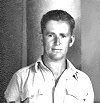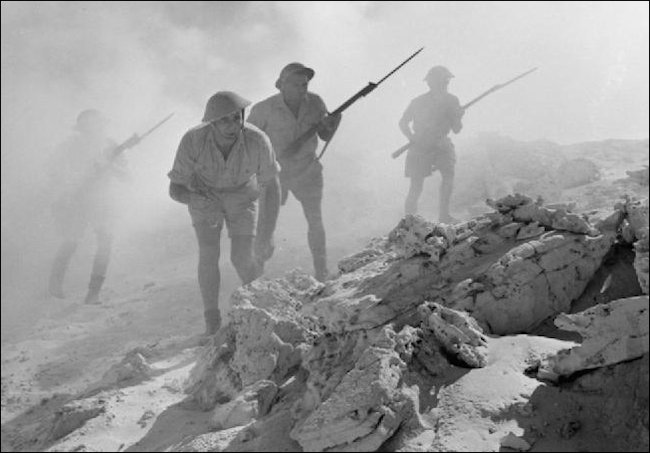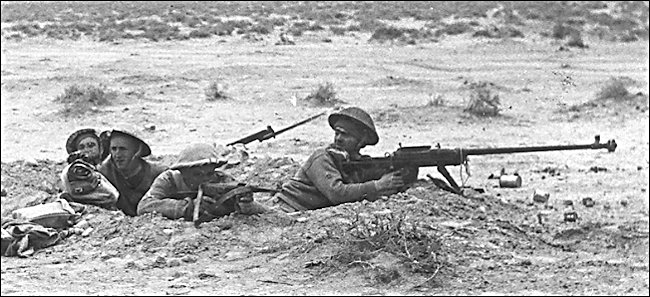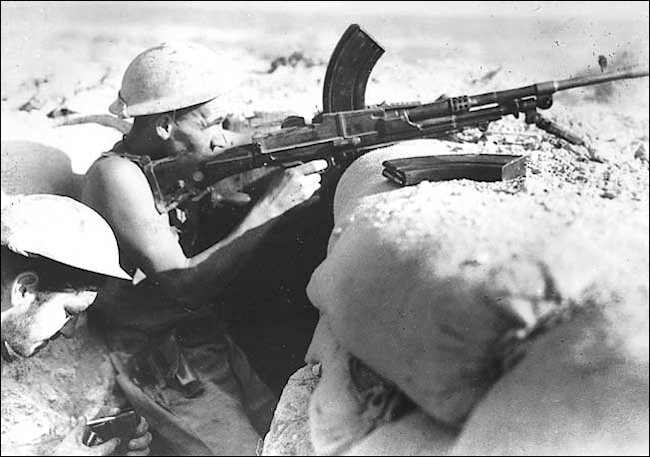2nd KRRC and the Battle of El Alamein 31st August 1942
Len Moore fought with the 2nd Battalion Kings Royal Rifle Corps 2/KRRC across the deserts of North Africa during WW2 from 1941 to 1943. In August 1942 he was involved in heavy fighting at the southern end of the El Alamein battle line.

Len Moore 2nd Battalion Kings Royal Rifle Corps
Rommel turned north and hit our main armour where there was a big tank battle, the Hun falling nicely into the trap laid for him. On the 7th Motor Brigade front the necessary withdrawal of 10th Hussars put our 2nd Battalion under a threat, which was increased when shortly afterwards thirty tanks of 90th Light Division penetrated the first minefield in Munassib depression and advanced along the boundary with 2nd Rifle Brigade.
Six tanks were knocked out but the rest continued the advance, and Brigadier Bosvile (late Rifle Brigade) was rightly concerned that this thrust and that further south might reach the lightly-held gaps in the second minefield before his Riflemen did. Our 2nd Battalion reported 'At 0600 hours orders were received to withdraw through our second minefield and this manoeuvre was completed without difficulty by 0710 hours. By this time it was light and many targets were heavily engaged by the Gunners.'
The advance of the D.A.K. eastwards south of Ragil depression and the pressure of the Reconnaissance Group along the escarpment against the 4th/8th Hussars and 1st Battalion rearguard was now further threatening to cut off the motor brigade in their own minefields. At 0920 hours our 2nd Battalion was ordered to fall back through the third minefield and to withdraw twelve miles east to a position position behind our armour, from which their remaining role in the battle was as escort to O.P.s harassing enemy concentrations.

British Infantry attack during the battle of El Alamein Aug-Sept 1942 North African Desert.
At about 0800 hours Rommel, after considering cancelling the operation because of its very poor progress, decided instead to make the Alam Halfa ridge itself the D.A.K. objective, rather than trying any wider wheel.
By midday on 31 August 90th Light and the Italians were still in the British minefields, but 21st Panzer in the north, with 15th Panzer to their south, were refueling west of our 1st Battalion's position in depth at Gaballa, which B Company had largely dug. The dust was starting to blow hard at 1300 hours when the two Panzer divisions set off north-east through the Ragil depression with the Reconnaissance Group on their eastern flank. Maj. J. Hope engaged the fifty tanks and other vehicles who came within range of his company's guns.
El Alamein Line 1st September 1942
On 1 September General Montgomery gave orders for the three Armoured Brigades to concentrate in the gap between Alam Halfa and the New Zealanders; in moving forward westwards from southeast of the ridge, 8th Armoured Brigade made contact with 15th Panzer for the first time. Their presence, a great weight of artillery fire from 44th Infantry Division on the ridge, and continuous attack by the Royal Air Force kept the D.A.K. inactive and inflicted many casualties; petrol supply was a critical factor in inhibiting Axis. Further south 7th Motor Brigade (including the 2/krrc) had moved into contact with movement.

Infantry at the Battle of El Alamein Aug 1942 armed with a Boys anti-tank rifle
The Reconnaissance Group, while our 1st Battalion struggled all day to keep up with 4th Light Armoured's tanks, who made better progress in the soft sand as they headed back the ten miles Gaballa. The aim was to probe the German flank around Himeimat, and this was achieved the next morning when 11th Hussars patrols by-passed the hill to the south, and a column of 4th/8th Hussars destroyed fifty-seven out of 300 lorries and chased the remainder north.
After this action, Rommel formalized an effective screen along this flank; his Italian tanks, working with German armoured cars and anti-tank guns, were far enough south for any approach along a narrow corridor above the Depression to Himeimat to be restricted to light tanks, because our guns and trucks bogged in the soft sand. There were opportunities for the 1st Battalion, however, like the occasion when B Company worked a 6-pounder forward at Gaballa and knocked out an armoured car. Lt P. Harker did excellent work with a Vickers mounted on a carrier, knocking out at least one anti-tank gun which was firing at one of our O.P.s.
The 2nd September was quiet, except in the air, and the British policy was 'gradually and methodically to close the gap'. On the 3rd, 1,000 enemy vehicles were reported moving west, and a pattern of three great columns withdrawing along their original routes became clear. Montgomery, with his autumn offensive to consider and unwilling to relax control over his Army, whose standards in all arms training he felt could be higher, had given orders that only patrols were to follow them; thus, enemy flank and rear guards were able to hold off the Motor and Light Armoured Brigades.
The efforts of the New Zealanders and a brigade of 44th Division to seize the northern rim of the Munassib depression during the night 3/4 September failed, and so only the R.A.F. were able to harass the main concentrations of the enemy as they withdrew. Never losing control of his rearguard, Rommel finally halted them on the line of the former British second minefield, keeping Himeimat firmly in his hands. Our 1st Battalion, dominated from this peak and plagued by myriad flies from the as yet unburied enemy bodies, set themselves to patrol and assist in the laying of three new minefields.

The 2nd KRRC were issued with Bren gun machineguns
'Nuts', 'May' and 'June' were fields running at rather over a mile's interval successively back from their old third minefield to Gaballa, and these ensured delay against any further German attack. Although Rommel had lost only about fifty tanks, over seventy more were damaged, and 370 trucks had been destroyed.
A stronger reason for not renewing an offensive was his very stock of petrol and ammunition. The weight of air attack and Montgomery's insistence on fighting wherever possible by formations rather than columns, which made it possible to concentrate artillery fire, made a considerable impression on Axis troops and their leader; for the first time since his arrival in the desert, Rommel found himself committed at the end of a tenuous supply line with no foreseeable prospect of regaining the initiative.
Although planning for the Alamein offensive was already in train on the British side, Riflemen were more concerned with the daily round. The 2nd Battalion KRRC moved into a rest area by the sea at Burg el Arab on 11 September, and the 1st were relieved by 1st Rifle Brigade a few days later for similar rest, swimming, shooting and maintenance of equipment.
Time was again pressing with a heavy political hand on the Middle East. In view of the complexity of the enemy minefields a full moon was needed for the projected 8th Army attack. After the battle of Alam Halfa, the necessary build-up of resources and training made the October full moon the earliest moment available to General Montgomery. However, this was in the eyes of the Prime Minister quite late enough, for Operation 'Torch', the Allied landing in North Africa was due in early November; and it was considered that an 8th Army victory before then would encourage the French to greet our arrival with enthusiasm.